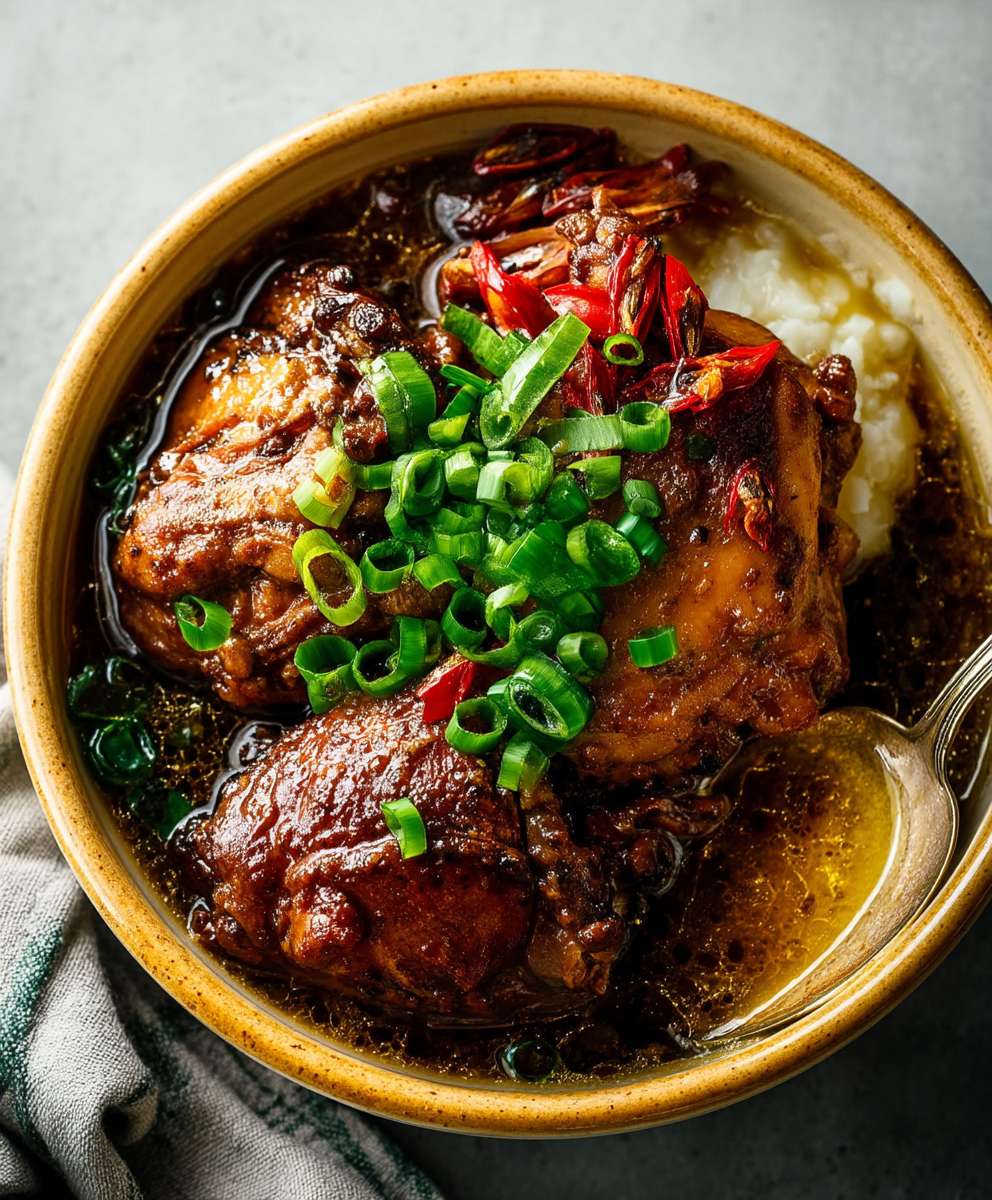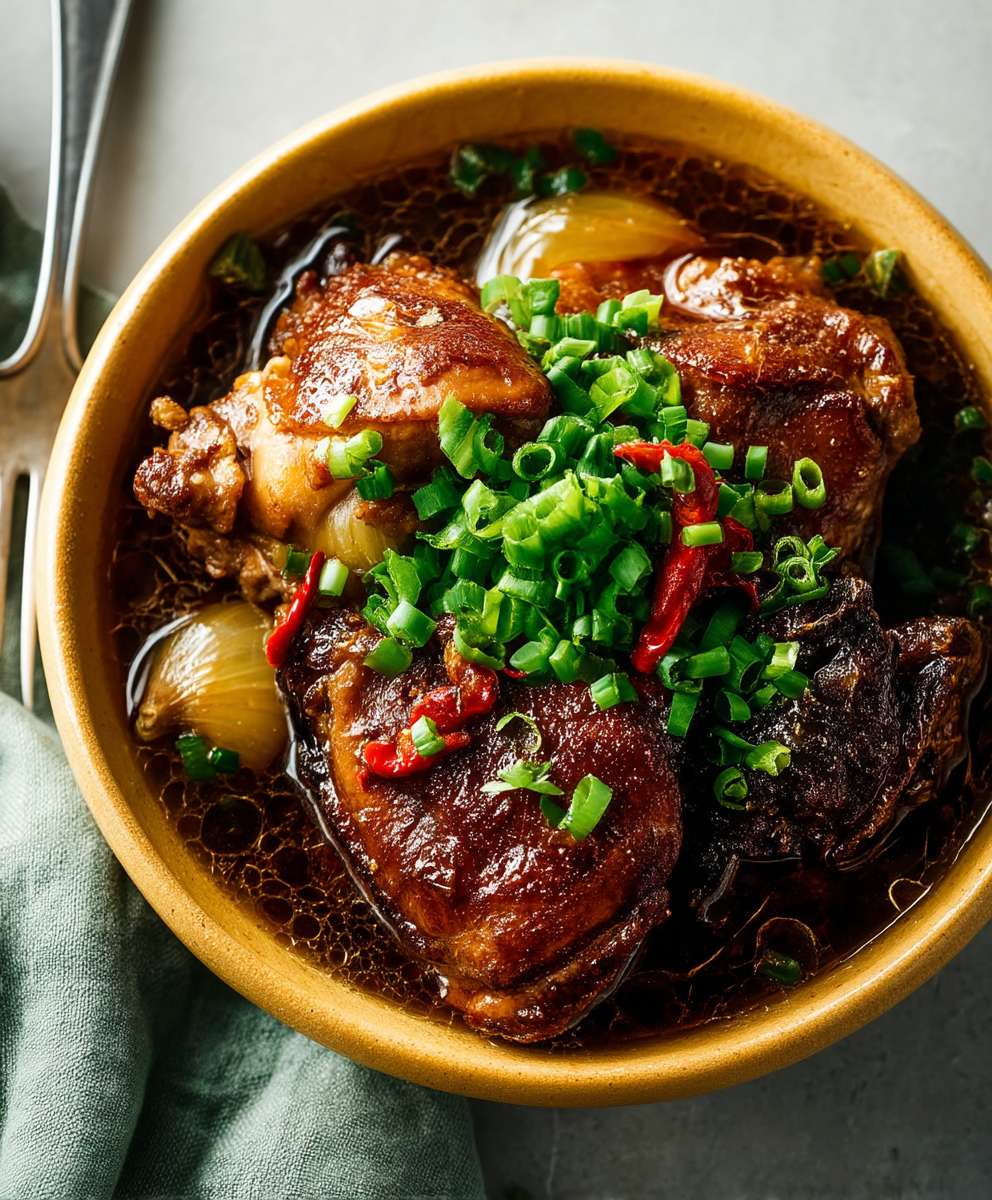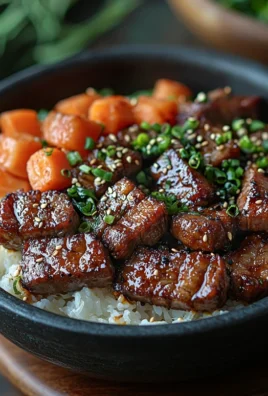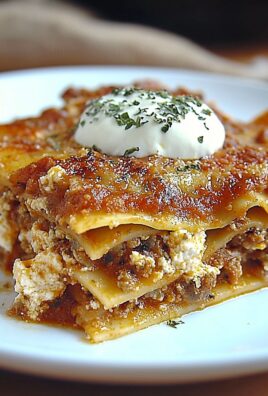Chicken Adobo: just the name conjures up images of savory, tangy, and utterly comforting goodness! Imagine tender chicken, simmered to perfection in a rich, flavorful sauce thats both deeply satisfying and surprisingly simple to make. Have you ever wondered why this dish is considered the unofficial national dish of the Philippines? It’s more than just a recipe; it’s a taste of home, a connection to heritage, and a testament to the resourcefulness of Filipino cuisine.
The beauty of Chicken Adobo lies in its history. It’s believed that the method of cooking in vinegar, soy sauce, garlic, and peppercorns predates refrigeration, serving as a natural preservative in the tropical climate. Over time, the dish evolved, incorporating influences from Chinese traders and Spanish colonizers, resulting in the delicious, complex flavors we know and love today. But why is it so beloved? Well, the combination of salty soy sauce, tangy vinegar, pungent garlic, and aromatic peppercorns creates an irresistible umami bomb that tantalizes the taste buds. The chicken becomes incredibly tender, practically falling off the bone, and the sauce is perfect for soaking into fluffy rice. Plus, it’s incredibly versatile! You can adjust the sweetness, sourness, and spiciness to your liking, making it a truly customizable dish. Whether you’re a seasoned cook or a kitchen novice, this recipe is guaranteed to impress. So, let’s dive in and discover the secrets to making the perfect Chicken Adobo!
Ingredients:
- 2 lbs Chicken pieces (thighs and drumsticks work best, but you can use any cut)
- 1 large Onion, quartered
- 6-8 cloves Garlic, minced
- 1/2 cup Soy Sauce (adjust to taste)
- 1/4 cup White Vinegar (adjust to taste)
- 1 cup Water
- 2 Bay Leaves
- 1 tbsp Black Peppercorns, whole
- 1 tbsp Brown Sugar (optional, for a touch of sweetness)
- 2 tbsp Cooking Oil
- Salt to taste (be careful, soy sauce is already salty)
- Green onions, chopped (for garnish, optional)
- Cooked Rice, for serving
Preparing the Chicken and Aromatics:
- First, let’s get our chicken ready. You can use any cut you like, but I find that thighs and drumsticks stay the most tender during the long braising process. No need to trim the fat excessively, as it will render down and add flavor to the sauce.
- Next, prepare the aromatics. Quarter the large onion. Don’t worry about making them too small, as they will soften and meld into the sauce as it cooks. Mince the garlic. I prefer to mince it finely, but you can also crush it if you prefer a more robust garlic flavor.
The Braising Process:
- Now, let’s start cooking! Heat the cooking oil in a large pot or Dutch oven over medium-high heat. Make sure the pot is large enough to accommodate all the chicken pieces without overcrowding. Overcrowding can lower the temperature of the oil and prevent the chicken from browning properly.
- Once the oil is hot, add the chicken pieces to the pot. Brown the chicken on all sides. This step is crucial for developing flavor. Don’t rush it! Let each side get a nice golden-brown color before flipping. Browning the chicken adds depth and complexity to the final dish. This usually takes about 5-7 minutes per side.
- Remove the browned chicken from the pot and set it aside. Don’t worry about cooking it all the way through at this point; it will finish cooking in the sauce.
- In the same pot, add the quartered onions and cook until softened and translucent, about 5-7 minutes. Stir occasionally to prevent them from burning. The onions will release their natural sugars and add sweetness to the sauce.
- Add the minced garlic to the pot and cook for about 1 minute, or until fragrant. Be careful not to burn the garlic, as it can become bitter.
- Pour in the soy sauce and vinegar. Let it simmer for a minute or two, scraping up any browned bits from the bottom of the pot. These browned bits, called fond, are packed with flavor and will add richness to the sauce.
- Add the water, bay leaves, and whole black peppercorns. The water will help to create a flavorful braising liquid. The bay leaves and peppercorns will add aromatic complexity to the dish.
- If you’re using brown sugar, add it now. The brown sugar will add a touch of sweetness and help to balance the acidity of the vinegar. You can adjust the amount of brown sugar to your liking, depending on how sweet you want the adobo to be.
- Return the chicken pieces to the pot, making sure they are mostly submerged in the liquid. Bring the mixture to a boil, then reduce the heat to low, cover the pot, and simmer for at least 45 minutes to 1 hour, or until the chicken is very tender and easily pulls away from the bone. The longer you simmer it, the more flavorful and tender the chicken will become.
- During the simmering process, check the pot occasionally and stir to prevent the chicken from sticking to the bottom. If the liquid is reducing too quickly, you can add a little more water.
Adjusting the Sauce and Serving:
- Once the chicken is cooked through and tender, remove it from the pot and set it aside.
- Increase the heat to medium-high and let the sauce simmer uncovered, allowing it to reduce and thicken. This will concentrate the flavors and create a richer, more intense sauce. This usually takes about 10-15 minutes.
- Taste the sauce and adjust the seasoning as needed. You may need to add a little more soy sauce for saltiness, vinegar for acidity, or brown sugar for sweetness. Remember that the sauce will continue to reduce and become more concentrated, so be careful not to over-season.
- Return the chicken pieces to the pot and coat them with the thickened sauce. Let them simmer for a few more minutes to warm through.
- Serve the chicken adobo hot over cooked rice. Garnish with chopped green onions, if desired. The rice will soak up the delicious sauce, making it the perfect accompaniment to the flavorful chicken.
Tips and Variations:
- Vinegar: The type of vinegar you use can affect the flavor of the adobo. White vinegar is the most common, but you can also use apple cider vinegar or cane vinegar for a slightly different flavor profile.
- Soy Sauce: Use a good quality soy sauce for the best flavor. I prefer to use a naturally brewed soy sauce.
- Sweetness: The amount of brown sugar you use is optional and depends on your preference. You can also use honey or even a little bit of pineapple juice for sweetness.
- Spice: If you like a little heat, you can add a pinch of red pepper flakes or a chopped chili pepper to the pot.
- Potatoes: Some people like to add potatoes to their chicken adobo. If you want to add potatoes, peel and cube them and add them to the pot along with the chicken.
- Hard-boiled Eggs: Another popular addition is hard-boiled eggs. Add them to the pot during the last 15 minutes of cooking to warm them through.
- Pork Adobo: You can also make adobo with pork instead of chicken. Use pork belly or pork shoulder for the best results. The cooking time will be longer for pork, so simmer it for at least 1.5 to 2 hours, or until the pork is very tender.
- Chicken Feet Adobo: For a more adventurous take, try making adobo with chicken feet. This is a popular dish in the Philippines and is known for its rich, collagen-rich broth.
- Adobo Flakes: Shred the cooked chicken and pan-fry it until crispy for adobo flakes, a great topping for rice or salads.
Serving Suggestions:
- Serve with steamed white rice or brown rice.
- Pair with a side of steamed vegetables, such as bok choy or green beans.
- Serve with a simple salad for a complete meal.
- Leftover adobo can be used in sandwiches, tacos, or burritos.
Storage Instructions:
- Store leftover chicken adobo in an airtight container in the refrigerator for up to 3-4 days.
- You can also freeze chicken adobo for up to 2-3 months. Thaw it in the refrigerator overnight before reheating.
- Reheat chicken adobo in a pot on the stovetop or in the microwave until heated through.
Why This Recipe Works:
This recipe works because it focuses on building layers of flavor. The browning of the chicken, the sautéing of the onions and garlic, and the simmering of the sauce all contribute to a complex and delicious final product. The balance of soy sauce, vinegar, and sweetness is also key to a successful adobo. By adjusting these ingredients to your liking, you can create an adobo that is perfectly tailored to your taste.
Troubleshooting:
- Sauce is too salty: If the sauce is too salty, add a little bit of water or brown sugar to balance the flavors.
- Sauce is too acidic: If the sauce is too acidic, add a little bit of brown sugar or soy sauce to balance the flavors.
- Sauce is too sweet: If the sauce is too sweet, add a little bit of vinegar or soy sauce to balance the flavors.
- Chicken is not tender: If the chicken is not tender, continue to simmer it until it is easily pulls away from the bone.
- Sauce is too thin: If the sauce is too thin, simmer it uncovered until it reduces and thickens. You can also add a cornstarch slurry (1 tablespoon cornstarch mixed with 2 tablespoons cold water) to the sauce to help thicken it.

Conclusion:
And there you have it! This isn’t just another recipe; it’s an invitation to experience the soul of Filipino cuisine. I truly believe this Chicken Adobo recipe is a must-try for anyone looking for a dish that’s both deeply flavorful and surprisingly simple to make. The combination of savory soy sauce, tangy vinegar, aromatic garlic, and bay leaves creates a symphony of tastes that will dance on your palate. It’s a dish that’s comforting, satisfying, and guaranteed to become a family favorite.
But why is this particular Chicken Adobo recipe so special? It’s all about the balance. I’ve spent years perfecting the ratios of ingredients to ensure that each bite is a harmonious blend of sweet, salty, and sour. It’s not just about throwing ingredients into a pot; it’s about understanding how they interact and complement each other. And trust me, the results are worth the effort.
Beyond its incredible flavor, this recipe is also incredibly versatile. Serve it over fluffy white rice for a classic Filipino experience. The rich sauce soaks into the rice, creating a truly unforgettable meal. Or, for a healthier option, try serving it with quinoa or cauliflower rice. You can even shred the chicken and use it as a filling for tacos or spring rolls. The possibilities are endless!
Looking for variations? Consider adding a touch of sweetness with a spoonful of brown sugar or honey. For a spicier kick, incorporate some chili flakes or a chopped chili pepper. Some people even like to add potatoes or hard-boiled eggs to their adobo for extra heartiness. Feel free to experiment and find what works best for your taste buds. Don’t be afraid to get creative and make this recipe your own!
Serving Suggestions:
* Classic: Serve over steamed white rice.
* Healthy: Pair with quinoa or cauliflower rice.
* Fusion: Use shredded chicken adobo as a filling for tacos or spring rolls.
* Side Dish: Steamed green beans or bok choy.
Variations:
* Sweet: Add 1-2 tablespoons of brown sugar or honey.
* Spicy: Incorporate chili flakes or a chopped chili pepper.
* Hearty: Add potatoes or hard-boiled eggs.
* Creamy: Stir in a splash of coconut milk at the end of cooking.
I’m so confident that you’ll love this Chicken Adobo recipe that I urge you to try it out as soon as possible. Gather your ingredients, follow the simple steps, and prepare to be amazed. And most importantly, don’t forget to share your experience with me! I’d love to hear your feedback, see your photos, and learn about any variations you’ve tried. Tag me on social media or leave a comment below. Let’s spread the love for this incredible Filipino dish together! I can’t wait to see your culinary creations! Happy cooking!
Chicken Adobo: The Ultimate Guide to the Perfect Filipino Dish
Tender chicken braised in a flavorful soy sauce, vinegar, and garlic sauce. A simple yet satisfying Filipino dish perfect served over rice.
Ingredients
- 2 lbs Chicken pieces (thighs and drumsticks work best, but you can use any cut)
- 1 large Onion, quartered
- 6-8 cloves Garlic, minced
- 1/2 cup Soy Sauce (adjust to taste)
- 1/4 cup White Vinegar (adjust to taste)
- 1 cup Water
- 2 Bay Leaves
- 1 tbsp Black Peppercorns, whole
- 1 tbsp Brown Sugar (optional, for a touch of sweetness)
- 2 tbsp Cooking Oil
- Salt to taste (be careful, soy sauce is already salty)
- Green onions, chopped (for garnish, optional)
- Cooked Rice, for serving
Instructions
- Prepare Chicken and Aromatics: Quarter the onion and mince the garlic.
- Brown the Chicken: Heat cooking oil in a large pot or Dutch oven over medium-high heat. Brown the chicken pieces on all sides (5-7 minutes per side). Remove chicken and set aside.
- Sauté Aromatics: In the same pot, add the quartered onions and cook until softened and translucent (5-7 minutes). Add the minced garlic and cook until fragrant (about 1 minute).
- Build the Sauce: Pour in the soy sauce and vinegar. Simmer for a minute or two, scraping up any browned bits from the bottom of the pot.
- Add Braising Liquid: Add the water, bay leaves, and whole black peppercorns. If using, add brown sugar.
- Braise the Chicken: Return the chicken pieces to the pot, ensuring they are mostly submerged in the liquid. Bring to a boil, then reduce heat to low, cover, and simmer for at least 45 minutes to 1 hour, or until the chicken is very tender. Check occasionally and stir to prevent sticking. Add more water if the liquid reduces too quickly.
- Reduce the Sauce: Remove the chicken from the pot and set aside. Increase the heat to medium-high and let the sauce simmer uncovered, allowing it to reduce and thicken (10-15 minutes).
- Adjust Seasoning: Taste the sauce and adjust the seasoning as needed (soy sauce, vinegar, or brown sugar).
- Combine and Serve: Return the chicken pieces to the pot and coat them with the thickened sauce. Simmer for a few more minutes to warm through. Serve hot over cooked rice, garnished with chopped green onions (optional).
Notes
- Vinegar: White vinegar is most common, but apple cider or cane vinegar can be used.
- Soy Sauce: Use a good quality, naturally brewed soy sauce.
- Sweetness: Brown sugar is optional; adjust to taste. Honey or pineapple juice can also be used.
- Spice: Add a pinch of red pepper flakes or a chopped chili pepper for heat.
- Variations: Potatoes or hard-boiled eggs can be added during the last 15 minutes of cooking. Pork can be substituted for chicken, but will require a longer cooking time (1.5-2 hours).
- Adobo Flakes: Shred the cooked chicken and pan-fry it until crispy for adobo flakes.
- Storage: Store leftovers in an airtight container in the refrigerator for up to 3-4 days or freeze for up to 2-3 months.
- Troubleshooting:
- Too salty: Add water or brown sugar.
- Too acidic: Add brown sugar or soy sauce.
- Too sweet: Add vinegar or soy sauce.
- Chicken not tender: Continue to simmer.
- Sauce too thin: Simmer uncovered or add a cornstarch slurry (1 tbsp cornstarch + 2 tbsp cold water).





Leave a Comment